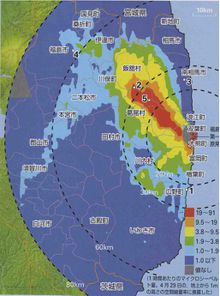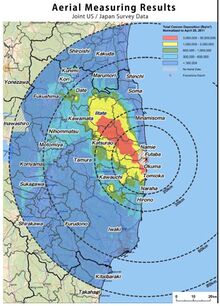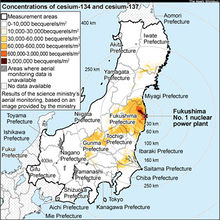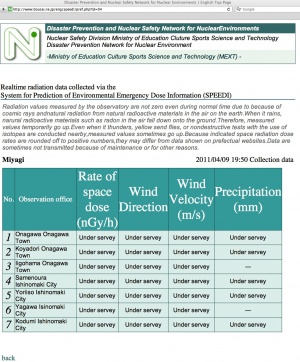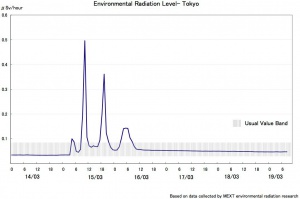Fukushima disaster
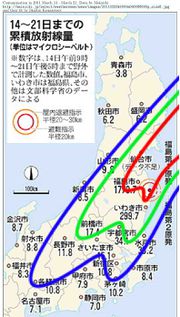
Fukushima disaster is the catastrophe 2011 March 11 at the Fukushima nuclear plant (Japan), coordinates [141.032917, 37.422972]. The catastrophe was caused by the series of the earthquakes in March 11 (estimated to have magnitude 8.9 by the Richter's scale) followed by the series of tsunami. The strong tsunami had destroyed the generators of cooling system of the reactors, causing explosions of some of them within a week after the earthquake. Wide radioactive contamination of the Honshu iceland (see the pic) is usually attributed to this catastrophe. During a month, the rank of the catastrophe raised up since 4 to 5 and then to 7; since 2011 April it is qualified with rank 7, the same as the Chernobyl disaster. In 2011 April, the level of radiation slows down; no future increase of the rank is expected.
2012 July 5, the official report on the event by the National Diet of Japan Fukushima Nuclear Independent Investigation Commission had been submitted to the Diet. Since 2012.10.17, the English translation is available [2]. The interpretation of the event by the official report may be be different from that presented below and based on the "unofficial" publications.
Since 2013, the daily updating maps of contamination of Japan are available at http://jciv.iidj.net/map/
Inetrpretations
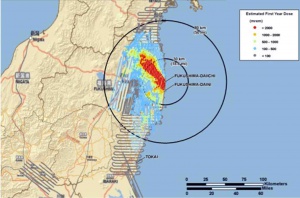
At the beginning of the earthquake, 2.46pm local time on March 11, 2011, all the reactors in Japan were quickly shut-down. After such an emergency stop, the reactor requires the forced cooling during several days, consuming the electric power. Such a cooling was arranged by special water-pumps and the emergency back-up generators. These generators were destroyed by the tsunami followed the earthquake. The mobile generators were sent, but their power is lower, than that the damaged back-up generators were supposed to provide. This caused lack of the cooling water pumped in to the hot cores of the reactors that caused the partial destruction of some of them, causing the series of explosions during a week after the earthquake.
The lack of information about the events at Fukushima and hiding of information about the contamination by the Japanese authorities enables the concept, that initially the accident was not so bad, but poor management and the irresponsible handling converted it to the world-wide disaster. The gradual development of the catastrophe has deep analogy with the Chernobyl disaster [7][8][9] and some authors consider it to be worse than Chernobyl [10][11][12][13]; in the case of Chernobyl, first, the explosion also was reported as a small accident.
Some 170,000 people have been ordered to evacuate the area covering a radius of 20 kilometers around the Fukushima plant. After a month, the evacuation zone had been extended to 30km. April 11, the severity rate is raised to 7, setting the accident to the same scale as the Chernobyl disaster [14]. Certain doubts are expressed if the operators of the station did their best while the catastrophe was unfolding [15]; the government is also criticized for hiding of the information about the catastrophe [16]. In 2011 May, meltdown of the cores of the reactors had been confirmed [17][18]. After such a confirmation, the map of contamination [5] is released.
Above the ground
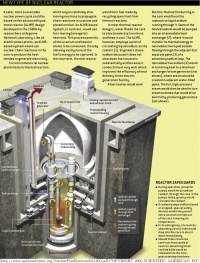
All the reactors at Fukushima are built-up above the ground. Past century, Nobel laureate Andrei Sakharov had told, that the above–ground nuclear reactors are dangerous and should be prohibited by the special law [20]; up to year 2021, such reactors are not yet prohibited. Until the 2011 March, many people in the Fukushima prefecture believed that the reactors are safe. The Fukushima catastrophe may be one additional important argument to push forward the prohibition of the above-ground reactors.
Robots
The journalists try to understand: why the country (which is most advanced in the industry of robots) had to send the workers-kamikaze to cool the reactors, instead of to send robots [21][22][23]. According to publications, no one robot took part in the cooling of the reactor, although some attempts to use a robot for the automatic registration of radiation are discussed [24][25].
Lack of information
As in the case of the Chernobyl disaster, the hiding of the information about the level of contaminaiton was the strongest warning about the danger. Correspondents of the Washington Post had mentioned that the representatives of the Tokyo Electric Company had revealed almost no information on the things that are happening [26][27].
2011 April 6, Sebastian Pflugbeil had expressed very negative opinion about the ability of the Japanese officials to provide the adequate information about the Fukushina's catastrophe [13]. During a month, these officials could not estimate even the order of magnitude of the amount of unstable isotopes released [14].
March 18, some data about the contamination were released [28] by the Government. Soon, the site of newspaper Mainichi had released the map [29] by Mainichi and compared to data [28] by the Government. The qualitative agreement takes place under assumption that the numbers at the Mainichi map mean amount of mS/year, while the data government use the unit \(\mu\)Sv/hour.
At the beginning of 2011 April, with enormous efforts by the emergency workers, the cooling of the reactors seems to be arranged; the situation seems to be stabilized at some intermediate level of emergency [30][31][32], but the officials from TEPCO and government have lost the fiance of the people [33][34]. The official maps with lines of constant level of radiation were not published, and the dangerous zone is still (beginning of April, 2011) considered as a circle (of radius of 30 km) centered at the Fukushima Daichi nuclear plant. The fit a the top figure cannot be considered as an official release. The information about the radiation at Sendai ( 仙台市 ) seems to be intentionally hidden. The hiding of the information about the disaster caused many foreign workers to leave from the country [34][35].
The first maps of contamination were provided by Declan Butler [36] and then by the Jonocelyn Kaiser [3] but neither by the Japanese government, nor by the TEPKO (who were expected to handle the case). As in the case of the USSR (Chernobyl, 1986), the citizen have to get information about events happening in their own country from the foreign publications.
More data
The data by "Nature" and "Science Insider" data could be used to correct the approximation of data by Mainichi, shown in the top figure, but the calibration is necessary to avoid effects of the observational selection: the data by Mainichi [29] lack the description of the methodic of evaluation. Then, the more recent and more detailed maps of contamination [3][5][37] were released.
2015 January, Kimiaki Saito, Yuichi Onda provide the detailed estimates about release of contaminants at the Fukushima disaster [38]:
Isotopes released, their Halflife and their radioactivity in Bq for 3 Reactors and Total
\( \displaystyle \begin{array}{ccccc} \rm Isotope & \rm Halflife &\rm Reactor~ 1 &\rm Reactor~ 2 &\rm Reactor~ 3 &\rm Total\\ \rm ^{133}Xe &\rm 5.2~ d & 3.4×10^{18} & 3.5×10^{18} & 4.4×10^{18} & 1.1×10^{19}\\ \rm ^{134}Cs &\rm 2.1~ y & 7.1×10^{14} & 1.6×10^{16} & 8.2×10^{14} & 1.8×10^{16}\\ \rm ^{137}Cs &\rm 30~ y & 5.9×10^{14} & 1.4×10^{16} & 7.1×10^{14} & 1.5×10^{16}\\ \rm ^{89}Sr &\rm 50.5~ d & 8.2×10^{13} & 6.8×10^{14} & 1.2×10^{15} & 2.0×10^{15}\\ \rm ^{90}Sr &\rm 29.1~ y & 6.1×10^{12} & 4.8×10^{13} & 8.5×10^{13} & 1.4×10^{14}\\ \rm ^{140}Ba &\rm 12.7~ d & 1.3×10^{14} & 1.1×10^{15} & 1.9×10^{15} & 3.2×10^{15}\\ \rm ^{127m}Te &\rm 109~ d & 2.5×10^{14} & 7.7×10^{14} & 6.9×10^{13} & 1.1×10^{15}\\ \rm ^{129m}Te &\rm 33.6~ d & 7.2×10^{14} & 2.4×10^{15} & 2.1×10^{14} & 3.3×10^{15}\\ \rm ^{131m}Te &\rm 30~ h & 2.2×10^{15} & 2.3×10^{15} & 4.5×10^{14} & 5.0×10^{15}\\ \rm ^{132}Te &\rm 78.2~ h & 2.5×10^{16} & 5.7×10^{16} & 6.4×10^{15} & 8.8×10^{16}\\ \rm ^{103}Ru &\rm 39.3~ d & 2.5×10^{09} & 1.8×10^{09} & 3.2×10^{09} & 7.5×10^{09}\\ \rm ^{106}Ru &\rm 368.2~ d & 7.4×10^{08} & 5.1×10^{08} & 8.9×10^{08} & 2.1×10^{09}\\ \rm ^{95}Zr &\rm 64~ d & 4.6×10^{11} & 1.6×10^{13} & 2.2×10^{11} & 1.7×10^{13}\\ \rm ^{141}Ce &\rm 32.5~ d & 4.6×10^{11} & 1.7×10^{13} & 2.2×10^{11} & 1.8×10^{13}\\ \rm ^{144}Ce &\rm 284.3~ d & 3.1×10^{11} & 1.1×10^{13} & 1.4×10^{11} & 1.1×10^{13}\\ \rm ^{239}Np &\rm 2.4~ d & 3.7×10^{12} & 7.1×10^{13} & 1.4×10^{12} & 7.6×10^{13}\\ \rm ^{238}Pu &\rm 87.7~ y & 5.8×10^{08} & 1.8×10^{10} & 2.5×10^{08} & 1.9×10^{10}\\ \rm ^{239}Pu &\rm 24065~ y & 8.6×10^{07} & 3.1×10^{09} & 4.0×10^{07} & 3.2×10^{09}\\ \rm ^{240}Pu &\rm 6537~ y & 8.8×10^{07} & 3.0×10^{09} & 4.0×10^{07} & 3.2×10^{09}\\ \rm ^{241}Pu &\rm 14.4~ y & 3.5×10^{10} & 1.2×10^{12} & 1.6×10^{10} & 1.2×10^{12}\\ \rm ^{91}Y &\rm 58.5~ d & 3.1×10^{11} & 2.7×10^{12} & 4.4×10^{11} & 3.4×10^{12}\\ \rm ^{143}Pr &\rm 13.6~ d & 3.6×10^{11} & 3.2×10^{12} & 5.2×10^{11} & 4.1×10^{12}\\ \rm ^{147}Nd &\rm 11~ d & 1.5×10^{11} & 1.3×10^{12} & 2.2×10^{11} & 1.6×10^{12}\\ \rm ^{242}Cm &\rm 162.8~ d & 1.1×10^{10} & 7.7×10^{10} & 1.4×10^{10} & 1.0×10^{11}\\ \rm ^{131}I &\rm 8~ d & 1.2×10^{16} & 1.4×10^{17} & 7.0×10^{15} & 1.6×10^{17}\\ \rm ^{132}I &\rm 2.3~ h & 1.3×10^{13} & 6.7×10^{06} & 3.7×10^{10} & 1.3×10^{13}\\ \rm ^{133}I &\rm 20.8~ h & 1.2×10^{16} & 2.6×10^{16} & 4.2×10^{15} & 4.2×10^{16}\\ \rm ^{135}I &\rm 6.6~ h & 2.0×10^{15} & 7.4×10^{13} & 1.9×10^{14} & 2.3×10^{15}\\ \rm ^{127}Sb &\rm 3.9~ d & 1.7×10^{15} & 4.2×10^{15} & 4.5×10^{14} & 6.4×10^{15}\\ \rm ^{129}Sb &\rm 4.3~ h & 1.4×10^{14} & 5.6×10^{10} & 2.3×10^{12} & 1.4×10^{14}\\ \rm ^{99}Mo &\rm 66~ h & 2.6×10^{09} & 1.2×10^{09} & 2.9×10^{09} & 6.7×10^{09} \end{array} \)
Discrepancy in the data
The scale of the disaster due to Fukushima happens to be much lower than that in the estimates [8][9][10][11] (and in particular, much lower than that due to the Chernobyl disaster); the main leaks of radiation seem to be fixed [39][31]. The nuclear fuel is supposed to remain in the confinement vessels, not burn up to the atmosphere, as in the case of Chernobyl. The question arises about the source of the contamination registered in the USA, Canada and other countries. Two hypothesis are described in the articles Who contaminates Japan and Russia used the nuclear weapon in 2011. Each of them can be considered as a kind of a conspiration theory, although the ways to check (to confirm or to negate) these hypothesis are suggested, and for beginning of 2011 April, no other explanation of the strong disagreement in the estimates of the level of contamination seem to be available.
None of the hypothesis mentioned above explains the apparent hiding of the information about radioactive contamination by the Japanese authorities. The detailed map of the contamination (similar to or better than that shown at the top figure) for 2011 March 11-21, as well as for the 2011 April would be the good answer; such answer appeared in 2011 June [37].
Chernobyl
The publications cause questions:
why the contamination registered at the USA coast allowed to compare the scale of the catastrophe to that due to the Chernobyl disaster, while no boiling of nuclear fuel into the atmosphere is reported at Fukushima?
Where is main source of the contamination?
The fit of data by Mainichi suggests that the main trend of the contamination does not go through the Fukushima nuclear plant, although perhaps goes through the epicenter of the earthquake of March 11 and through the Shikotan island (that currently is controlled by the Russian military troops).
In the later maps of the contamination, say, since 2011 April, the main spot of contamination seem to be at Fukushima-1; then it seems to be dominant source of radioactivity. Tetsuo Matsui (Institute of Physics, University of Tokyo, Komaba, Tokyo, Japan) shows that the ratio of isotopes released indicates that the chain reaction at the Unit-2 reactor at Fukushima had been reignited after the earthquake [40]. Such a concept contradicts the statements by TEPCO that the all the reactors were successfully shut down.
Chelsea Whyte (referring to Gerry Thomas at Imperial College, London) estimates that the Chernobyl nuclear disaster released 10 times as much radiation as Fukushima Daiichi [41].
Don Higson indicates that the amount of victims of the Chernobyl disaster is for orders of magnitude higher than that due to the Fukushima disaster [42]. His opinion agrees with the concept that the Chernobyl disaster was intentionally caused by the bad will of the soviet veterans (not only by their poor education and ignorance, see the article nuclear chimney), although the published information still does not allow to choose between various interpretations of the events.
Questions
Several other questions are formulated about this accident. 2011 March 19, the link to the questions below has been uploaded to the the Cabinet of the Prime Minister of Japan, at the section about the Countermeasures for the Great East Japan Earthquake [43]. As no reply has been received, the questions are moved to Fukushima disaster, questions; some of them are already with answers there.
Afterwards
The detailed map of contamination appears at http://www.nnistar.com/gmap/fukushima.html with delay of three months since the disaster. There are no indications about its future update since summer, 2011.
In the summer of 2011, the new reports about the sabotage in the Japanese government appear. One indicates, that the government had the preliminary information about the shape of the fallout, but lated for weeks with the release, exposing the population to the radiation. The information about the shape of the fallout was ignored and hidden by the Government. [44]
The Fukushima Network for Saving Children from Radiation qualify the behavior of Japanese Government in terms "Violation of the Human Rights of the Children of Fukushima" [45].
At the end of September, 2011, under the pressure of numerous protests, the government of Kan Naoto had to resign.
2011 December 16, the prime minister Yoshihiko Noda had declared that the consequences of the disaster due to the explosions of the nuclear reactors at the Fukushima 1 nuclear plant are under control [46], although it is not clear, what conditions melted fuel remains in the reactors or keep radioactive materials from being released outside. The next step of recovery after the disaster may take decades [47]. The people evacuated from Fukushina demand the apology payment of $625 a month for each victim until all the radiation from the accident is wiped out [48].
In 2012, the sabotage of the officials distributing of the most important information – data of the radiation monitoring – is still discussed [49]. The inability of the Japan administration to handle and to distribute the information is strong argument against any nuclear plant. The perspectives of the future development of Japan without nuclear power are considered [50][51].
In 2012, the new fraud about Fukushima has been reported by the RT agency [52]. According to the news, the administration asked the workers to provide fake data about the radiation exposure. Such a fraud add doubts to the question about ability of the human society to deal with nuclear energy in a civilized way. However, the RT agency do not specify the sources of information, nor name the persons, organized the fraud.
The updated map of contamination is available at http://jciv.iidj.net/map/
References
- ↑ http://mainichi.jp/select/weathernews/news/images/20110323k0000m040088000p_size8.jpg Mainichi. Table of contamination for 2011 March 14–21. (In Japanese; since 2014, not available)
- ↑ http://warp.da.ndl.go.jp/info:ndljp/pid/3856371/naiic.go.jp/en/report/index.html National DIet of Japan Fukushima Nuclear Independent Investigation Commission. Main report. This English translation of the report is a direct translation of the main report. 2012/10/25. NAIIC has verified that at the time the Great East Japan Earthquake occurred, the structure of the Fukushima Daiichi Nuclear Power Plant was not capable of withstanding the effects of the earthquake or the tsunami. Nor was the nuclear power plant prepared to respond to a severe accident. In spite of the fact that Tokyo Electric Power Company (TEPCO) and the regulators were aware of the risk from such natural disasters, neither had taken steps to put preventive measures in place. This was the fundamental reason for the accident; it could have been prevented if these matters had been attended to appropriately.
- ↑ Jump up to: 3.0 3.1 3.2 http://news.sciencemag.org/scienceinsider/2011/04/a-map-of-fukushimas-radiation.html?ref=hp Jocelyn Kaiser. A Map of Fukushima's Radiation Risks. 22 April 2011, 11:17 AM, Data by DOE
- ↑ http://www.newtonpress.co.jp/science/newton Map of contamination. Newton Graphic Science Magazine, 2011, issue 7, p. 27. (In Japanese)
- ↑ Jump up to: 5.0 5.1 5.2 http://www.iaea.org/newscenter/news/tsunamiupdate01.html Fukushima Nuclear Accident Update Log, Staff Report. Updates of 12 - 18 May 2011 (posted May 20, 2011)
- ↑ http://ajw.asahi.com/article/0311disaster/fukushima/AJ2011111217258 Radioactive cesium spread as far as Gunma-Nagano border. November 12, 2011
- ↑ http://www.cbc.ca/news/world/story/2011/03/12/earthquake-japan-nuclear-explosion.html Partial meltdown likely: Japanese official. The Associated Press Posted: Mar 12, 2011 A partial meltdown was likely under way at a second nuclear reactor... Some 170,000 people have been ordered to evacuate the area covering a radius of 20 kilometres.. Chief Cabinet Secretary Yukio Edano said operators released slightly radioactive air from Unit 3 Sunday, while injecting water into it as an effort to reduce pressure and temperature to save the reactor from a possible meltdown...
- ↑ Jump up to: 8.0 8.1 http://www.newscientist.com/article/dn20285-fukushima-radioactive-fallout-nears-chernobyl-levels.html Debora MacKenzie. Fukushima radioactive fallout nears Chernobyl levels. 17:14 24 March 2011.
- ↑ Jump up to: 9.0 9.1 http://www.themoneyparty.org/main/?p=1519 Michael Collins. Fukushima radioactive fallout nears Chernobyl levels. 2011 March 25.
- ↑ Jump up to: 10.0 10.1 http://www.novinite.com/view_news.php?id=126888 Russian Expert: Fukushima Disaster Greater Than Chernobyl World | April 2, 2011, Saturday ... A Russian nuclear expert has stated that the crisis situation in Fukushima is much worse than that in Chernobyl and might lead to a change in the scale for measuring nuclear emergencies. // "The crisis in Japan will cost a lot more than Chernobyl in terms of economic and human losses," according to nuclear engineer Nataliya Mironova
- ↑ Jump up to: 11.0 11.1 http://rus.ruvr.ru/2011/03/18/47628439.html Сергей Кириенко. Трагедия на японской АЭС Фукусима неизбежна. 18.03.2011, 18:16. Японские ликвидаторы, охлаждающие реакторы японской АЭС "Фукусима-1", лишь сдерживают темпы ухудшения ситуации, но не могут остановить ее развитие, заявил глава "Росатома" Сергей Кириенко на заседании Совбеза. (in Russian)
- ↑ http://www.ruskline.ru/news_rl/2011/03/14/konec_yaponskogo_chuda/ Иерей Александр Шумский. Конец «японского чуда». 14.03.2011. ... Практически все русские люди, в один голос, не сговариваясь, утверждают, что страшный природный катаклизм в Японии есть возмездие этой стране за оскорбление нашего Отечества.... подобная катастрофа и даже ещё более страшная в любой момент может произойти снова... (in Russian)
- ↑ Jump up to: 13.0 13.1 http://www.mcot.net/cfcustom/cache_page/192061.html Int'l conference on Chernobyl opens in Berlin. BERLIN, April 7 (Itar-Tass) -- Participants in an international conference on the 25th anniversary of the Chernobyl nuclear power plant disaster that opened in Berlin on Wednesday, April 6, discussed the impact of radiation on human health... President Sebastian Pflugbeil said the situation at Fukushima-1 differed from that at Chernobyl where an explosion had occurred followed by an immediate release of radiation. In Japan, things are happening gradually but the level of radioactivity at the six Japanese reactors is higher than that at Chernobyl... Pflugbeil expressed regret that Japan's information policy in connection with the nuclear accident does not differ from that of the Soviet authorities during the Chernobyl disaster.
- ↑ Jump up to: 14.0 14.1 http://www.washingtonpost.com/world/japan-to-raise-rating-of-nuclear-crisis-to-highest-level/2011/04/11/AFxrFEND_story.html Chico Harlan. Japan rates nuclear crisis at highest severity level. Washington Post, Monday, April 11, 10:22 PM.TOKYO — Japanese authorities raised Tuesday their rating of the severity of the Fukushima Daiichi nuclear crisis to the highest level on an international scale, equal to that of the 1986 Chernobyl disaster.
- ↑ http://online.wsj.com/article/SB10001424052748703922504576273234110896182.html PHRED DVORAK. Reactor Team Let Pressure Soar. APRIL 23, 2011. Japanese nuclear-power companies are so leery of releasing radiation into the atmosphere that their rules call for waiting much longer and obtaining many more sign-offs than U.S. counterparts before venting the potentially dangerous steam that builds up as reactors overheat, a Wall Street Journal inquiry found... The controversy has reached Japan's embattled Prime Minister Naoto Kan. Shortly after 7 a.m. that same morning, Mr. Kan paid a 50-minute visit to the Fukushima Daiichi grounds and held a meeting there with plant executives. Opposition lawmakers have argued that his visit distracted plant managers, while Mr. Kan's supporters say he pushed to accelerate venting...
- ↑ http://kuwaitsamachar.com/index/news/japanese-plant-starts-installation-filters Japanese plant starts installation of filters. 2011-May-03. .. Ministry of Economy, Trade and Industry disclosed that 68 of its former senior officials have ended up working for power companies in the past 50 years, illustrating a close relationship between the regulatory body and the industry, and raising suspicion that regulatory failure could be partly responsible for the latest nuclear disaster... The government continues to face criticism after the resignation of a key nuclear adviser Saturday over disagreements on information disclosure and radiation exposure limits.. ..The resigned government adviser, Toshiso Kosako, criticized the government for failing to abide by its own rules requiring the disclosure of forecasts based on potential scenarios.
- ↑ http://www.telegraph.co.uk/news/worldnews/asia/japan/8509502/Nuclear-meltdown-at-Fukushima-plant.html By Julian Ryall. Nuclear meltdown at Fukushima plant. 12 May 2011. Previously, Tepco believed that the core of the reactor was submerged in enough water to keep it stable and that only 55 per cent of the core had been damaged... "We will have to revise our plans," said Junichi Matsumoto, a spokesman for Tepco. "We cannot deny the possibility that a hole in the pressure vessel caused water to leak".
- ↑ http://mdn.mainichi.jp/mdnnews/news/20110517p2a00m0na010000c.html Mainichi Japan. TEPCO documents reveal chaos at Fukushima nuke plant after quake, tsunami. May 17, 2011. Coming more than two months after the disaster, the TEPCO data will soon be dissected by a government committee set up to analyze the causes of the nuclear crisis and the actions taken by both the government and TEPCO to contain it.
- ↑ http://www.nationalcenter.org/NuclearFastReactorsSA1205.pdf W.H.Hannum, G.E.Marsh, G.S.Stanford. Smarter Use of Fast-neutron reactors could extract much more energy from recycled nuclear fuel, minimize the risks of weapons proliferation and markedly reduce the time nuclear waste must be isolated. Scientific American, 2005 December, p.87.
- ↑ http://www.sakharov-archive.ru/Raboty/Rabot_22.htm А. Д. Сахаров. ПРЕДИСЛОВИЕ К ПОВЕСТИ Г. МЕДВЕДЕВА «ЧЕРНОБЫЛЬСКАЯ ТЕТРАДЬ» ..Лично я убежден, что ядерная энергетика необходима человечеству и должна развиваться, но только в условиях практически полной безопасности, что реально требует размещения реакторов под землей. Нужен международный закон, запрещающий наземное расположение реакторов. Медлить нельзя. (in Russian)
- ↑ http://www.newser.com/story/114384/japan-robots-where-are-they-amid-this-nuclear-disaster.html Nick McMaster. Japan Has Robots All Over —Except Nuke Plant. Mar 17, 2011 2:32.
- ↑ http://www.boingboing.net/2011/03/17/japan-nuclear-crisis-1.html Maggie Koerth-Baker. Japan nuclear crisis: Where are the robots? 10:22 AM Thursday, Mar 17, 2011.
- ↑ http://www.telegraph.co.uk/news/worldnews/asia/japan/8388394/Japan-earthquake-no-place-for-robots-as-human-heroes-stave-off-meltdown.html John Bingham. 5:29PM GMT 17 Mar 2011. It has built robots to take the place of chefs, concert pianists and even sumo wrestlers but when it comes to the perilous task of staving off nuclear disaster Japan has been left relying on human efforts.
- ↑ http://www.scientificamerican.com/article.cfm?id=robots-arrive-fukushima-nuclear Larry Greenemeier. Robots Arrive at Fukushima Nuclear Site with Unclear Mission. March 24, 2011. Mitsui's 600-kilogram Moni-Robo is reportedly on site at Daiichi.
- ↑ http://www.yomiuri.co.jp/dy/national/T110502002997.htm Yomiuri Shinbun. Unmanned machines enlisted at N-planr. Yomiuri, 2011 May 3.
- ↑ http://www.washingtonpost.com/business/economy/nuclear-crisis-deepens-as-third-reactor-loses-cooling-capacity/2011/03/14/ABk6rQV_story_1.html Brian Vastag and Chico Harlan. New fire reported at nuclear plant as Japan races to avert catastrophe. Tuesday, March 15, 6:41 PM .. NHK television reported that the Japanese government had ordered the country’s 47 prefectures to publicly report recorded radiation levels twice a day... Higher-than-normal radiation levels were detected in Tokyo, roughly 150 miles from Fukushima.. In Ibaraki, roughly 70 miles from Tokyo, levels were briefly 100 times the normal measure, according to the Kyodo news agency.. Amid the four-day-long emergency at the Fukushima Daiichi plant, Japan’s public has grown skeptical about the reliability of official information, criticizing Tokyo Electric officials in particular for their vague answers during news conferences.// Kan himself was not briefed on the Tuesday morning explosion until after it had been reported on television. According to a Kyodo reporter who overheard the conversation, Kan later grilled the company representatives, asking, “What the hell is going on?”// During a midmorning news conference, four Tokyo Electric officials revealed almost no information about the blast.
- ↑ http://www.washingtonpost.com/world/anxious-foreigners-flee-japan/2011/03/15/ABrlvnW_story.html Rick Maese and Erin Cox. Anxious foreigners flee Japan. Washington Post, Tuesday, March 15, 10:14 PM The lack of information — or the unreliability of it — has frustrated not only citizens, but also foreigners who call Japan home.
- ↑ Jump up to: 28.0 28.1 http://www.mext.go.jp/component/a_menu/other/detail/__icsFiles/afieldfile/2011/03/17/1303724_6_3.pdf Table of contamination for 2011 March 16-17, in Japanese.
- ↑ Jump up to: 29.0 29.1 http://mainichi.jp/select/weathernews/news/images/20110323k0000m040088000p_size8.jpg Map of contamination for 2011 March 14-21, in Japanese.
- ↑ http://www.iaea.org/newscenter/news/tsunamiupdate01.html Fukushima Nuclear Accident Updates of 6 April 2011. At 6:07 UTC, 5 April coagulation agents (liquid glass) were injected into the holes drilled around the pits. The leakage was reported to have ceased at 20:38 UTC on April 5. Work continues to prevent further releases to the sea.
- ↑ Jump up to: 31.0 31.1 http://in.reuters.com/article/2011/04/07/idINIndia-56176220110407 Japan's nuclear crisis. Thu Apr 7, 2011 8:41am IST. The head of a U.N. Scientific body says the situation at the plant is not expected to have any serious impact on people's health.
- ↑ http://www.enewspf.com/latest-news/latest-national/23591-international-atomic-energy-agency-briefing-on-fukushima-nuclear-accident-18-april-2011-1535-utc.html On Monday, 18 April 2011, the IAEA provided the following information on the current status of nuclear safety in Japan: ..situation at the Fukushima Daiichi nuclear power plant remains very serious but there are early signs of recovery..
- ↑ http://www.washingtonpost.com/world/peace-of-mind-livelihood-gone-for-japanese-dairy-farmers-near-evacuation-zone/2011/04/01/AFxieedC_story.html Andrew Higgins. Peace of mind, livelihood gone as Japanese city withers in shadow of nuclear plant. April 4, 2011. ...Radiation data released daily by the regional government, however, show just how difficult it is to work out who is and who isn’t at risk. Fukushima City, the regional capital, is much farther from Fukushima Daiichi than Minami Soma but has far higher radiation readings. The level of hazard depends not just on distance but a host of often inscrutable factors such as local topography and wind patterns... The danger may or may not be grave, but one thing is certain: Confusing and often contradictory announcements by jittery officials in Tokyo and shifty obfuscation by Tokyo Electric Power Co. executives have already stripped the Okubos of their livelihood, their peace of mind and the fruit of decades of labor...
- ↑ Jump up to: 34.0 34.1 http://www.vancouversun.com/news/Radiation+fear+drives+Richmond+family+from+Sendai+home/4501073/story.html Gillian Shaw. Radiation fear drives Richmond family from Sendai home. March 25, 2011. .. "People have a little bit of distrust for the government," he said. "They don't trust them, they are frustrated with the slow time and the gap in receiving information." ..
- ↑ http://mdn.mainichi.jp/mdnnews/business/news/20110425p2a00m0na022000c.html Industries left short-handed after foreign workers flee Japan following nuke accident. (Mainichi Japan) April 25, 2011. Tens of thousands of worried foreign workers left Japan shortly after a crisis at the nuclear power plant that was crippled by the March 11 earthquake and tsunami, causing serious labor shortages in some industries.
- ↑ http://blogs.nature.com/news/thegreatbeyond/2011/03/fukushima_update_against_the_o_1.html Declan Butler. Fukushima update: Recovery efforts stalled, as hotspot concerns grow - March 30, 2011
- ↑ Jump up to: 37.0 37.1 http://www.nnistar.com/gmap/fukushima.html Map of contamination, 2011 June
- ↑ https://www.sciencedirect.com/science/article/pii/S0265931X14003105 Kimiaki Saito, Yuichi Onda. Outline of the national mapping projects implemented after the Fukushima accident. Journal of Environmental Radioactivity, Volume 139, January 2015, Pages 240-249 https://doi.org/10.1016/j.jenvrad.2014.10.009 The national mapping projects were implemented..
- ↑ http://www.iaea.org/newscenter/news/tsunamiupdate01.html Fukushima Nuclear Accident Updates of 6 April 2011. At 6:07 UTC, 5 April coagulation agents (liquid glass) were injected into the holes drilled around the pits. The leakage was reported to have ceased at 20:38 UTC on April 5. Work continues to prevent further releases to the sea.
- ↑ http://arxiv.org/abs/1105.0242v1 T. Matsui. Deciphering the measured ratios of Iodine-131 to Cesium-137 at the Fukushima reactors. 2 May 2011. The data of the water samples from the unit-4 cooling pool and from the subdrain near the unit-2 reactor show anomaly which may indicate, if they are correct, that some of these fission products were produced by chain nuclear reactions reignited after the earthquake.
- ↑ http://www.newscientist.com/article/dn21181-radiation-levels-in-fukushima-are-lower-than-predicted.html Chelsea Whyte. Radiation levels in Fukushima are lower than predicted 22:00 16 November 2011.
- ↑ http://www.newscientist.com/article/mg21328566.500-dont-compare-fukushima-to-chernobyl.html Don Higson. Don't compare Fukushima to Chernobyl. 16 March 2012.
- ↑ http://www.kantei.go.jp/foreign/index-e.html Countermeasures for the Great East Japan Earthquake.
- ↑ http://www.nytimes.com/2011/08/09/world/asia/09japan.html?_r=1 Norimitsu Onishi, Martin Fackler, Ken Belson, Kantaro Suzuki. Japan withheld nuclear radiation data, leaving evacuees in peril. August 11, 2011 .. the forecasts were left unpublicized by bureaucrats in Tokyo.. ..The computer forecasts were among many pieces of information the authorities initially withheld from the public..
- ↑ http://www.greenaction-japan.org/internal/110817_Fukushima_human_rights_UN_submission.pdf The Fukushima Network for Saving Children from Radiation: Violation of the Human Rights of the Children of Fukushima. 17 August 2011.
- ↑ http://ajw.asahi.com/article/0311disaster/fukushima/AJ201112160059 Prime minister declares nuclear crisis under control. December 16, 2011. Tokyo Electric Power Co., operator of the plant, has not been able to explain in what conditions melted fuel remains in the reactors or keep radioactive materials from being released outside the plant premises.
- ↑ http://ajw.asahi.com/article/0311disaster/fukushima/AJ201112170019 Long road looms for next stage at Fukushima nuke plant. December 17, 2011. With the government declaring Dec. 16 that Step 2 of the road map for bringing the Fukushima No. 1 nuclear power plant under control has been completed, that starts the long and difficult next stage, which could take decades.
- ↑ http://www.staradvertiser.com/news/breaking/184559821.html?id=184559821 Yuri Kageyama. Okinawa welcomes Japanese fleeing Fukushima disaster. Dec 22, 2012. Sato and Kubota are joining a class-action lawsuit being prepared against the government and Tokyo Electric on behalf of Fukushima-area residents affected by the meltdowns. It demands an apology payment of $625 a month for each victim until all the radiation from the accident is wiped out, a process that could take decades, if ever, for some areas.
- ↑ http://ajw.asahi.com/article/0311disaster/fukushima/AJ201206180048 Government ignored U.S. radiation monitoring data in days after 3/11. June 18, 2012. The Energy Department used its Aerial Measuring System (AMS) between March 17 and 19, 2011, and compiled a detailed map of radiation levels on the basis of 40 hours of flight time over Fukushima Prefecture.// The data was provided to Japanese government officials, but not released to the public.
- ↑ http://edition.cnn.com/2012/06/27/world/asia/japan-nuclear-power/index.html Yoko Wakatsuki. Japan set to power up nuclear reactor amid protests. June 27, 2012 -- Updated 1113 GMT (1913 HKT).
- ↑ http://www.japantoday.com/category/national/view/tepco-kepco-shareholders-vote-to-keep-nuclear-power TEPCO / KEPCO shareholders vote to keep nuclear power. NATIONAL JUN. 28, 2012 - 06:07AM JST
- ↑ http://www.rt.com/news/fukushima-radiation-fake-readings-763/ Fukushima contractor forced workers to fake radiation readings. Published: 22 July, 2012, 01:32
Monitoring of contamination in prefectures
http://www.jaea.go.jp/english/index.shtml Japan Atomic energy Agency
http://erms.jaea.go.jp/ monitoring at Tokai section, Ibaraki with wind direction (in Japanese)
http://www.mext.go.jp Monitoring of the contamination (文部科学省) , in Japanese
http://www.bousai.ne.jp/eng/ Current contamination updated
http://www.mext.go.jp/english/incident/1303986.htm
temporal behavior in some cities.
http://park30.wakwak.com/~weather/geiger_index.html Monitoring at Tokyo
http://mextrad.blob.core.windows.net/page/13_Tokyo_en.html for April 2011 indicates \(0.09 \mu \rm Sv/h\)
http://park30.wakwak.com/~weather/geiger_index.html \(15 {\rm CPM} \approx \frac{15}{120}\rm microSievert/hour \approx 0.125 microSievert/hour\).
http://www.unscear.org/docs/reports/gareport.pdf background raduation 2.4 mSv/year \(\approx \frac {2.4}{24\cdot 365.25} \rm mSv/hour\approx 0.3 \mu Sv/hour\).
More links without numbers
http://www.youtube.com/watch?v=yp9iJ3pPuL8 Inside report from Fukushima nuclear reactor evacuation zone. Apr 6, 2011.
http://www.worldvillage.org/fia/kinkyu_english.php Fukushima prefecture, English versions of the official reports
http://www.kantei.go.jp/saigai/ Prime minister of Japan and his cabinet (official site, in Japanese)
http://www.kantei.go.jp/foreign/index-e.html (Official site, English version)
http://www.tepco.co.jp/index-j.html 東京電力からのお願い (in Japanese)
http://www.tepco.co.jp/en Press Release (Mar 11,2011)
http://www.nei.org/filefolder/Report_-_BWR_Mark_I_Containment_03192011_2.pdf (2011)
http://en.wikipedia.org/wiki/Fukushima_I_nuclear_accidents
http://en.rian.ru/photolents/20110315/163014558_3.html
http://radiation.goo.ne.jp/
http://www.scientificamerican.com/article.cfm?id=japan-nuclear-fallout John Matson. Fast Facts about Radiation from the Fukushima Daiichi Nuclear Reactors. March 16, 2011.
http://radjournal.com/articles/fukushima.htm Continuing Updates
Even more links in chronologic order are at Fukushima disaster, timeline of links.
See also Who contaminates Japan? (Kouznetsov) and Letter to Emperor (Kouznetsov) on the same topic.
